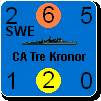Shannon V. OKeets
Posts: 22095
Joined: 5/19/2005
From: Honolulu, Hawaii
Status: offline

|
I am looking very closely at the air transport and paradrop missions, in light of the clarifications to the rules. In doing so, I have come across a possible problem. But first let me establish a little context, before jumping into the most complex case.
An ATR can start empty or carrying another unit/cargo for an air transport mission. For a paradrop mission, it has to be carrying a qualified unit/cargo. Let’s call its starting hex O for point of origination. The weather in the hex O does not matter for either air transport or paradrop missions. The weather in the destination hex, D, does matter, and may prevent either mission type from being flown.
For air transport missions, the ATR may start empty in hex O and pick up a unit/cargo in hex D. Whether dropping off or picking up cargo in hex D, the air transport mission requires that the ATR be capable of landing in hex D, though it does not have to actually land there. For instance, normally the terrain in hex D could not be mountain.
For paradrop missions, the ATR has to be capable of landing in D, if D is a friendly controlled hex (explicitly stated in the rules). Implicit from that statement is that a paradrop can be made into hex D, even if the ATR can not land there, but if and only if the hex is enemy controlled.
After completing their mission in hex D, both air transport and paradrop missions fly to a return hex, R. Since both air transport and paradrop missions are subject to air-to-air and anti-air combat in hex D, they might be aborting their mission when they fly to R.
Now the tricky bit is that an ATR is forbidden from returning to R with cargo if the weather in R is bad (storm/blizzard). Note that if it is empty, the ATR can return to a bad weather hex. And if the weather isn’t bad, the ATR can return with cargo. The abort result can produce a situation where the ATR still has its cargo and has to find a return hex with acceptable weather.
So my question is what happens to the ATR and its cargo that has been forced to abort, with cargo, from an air transport or paradrop mission when there is no viable return hex due to bad weather?
One partial solution is that for an air transport mission the ATR be forced to land in D, which has good weather and where we know it is capable of landing. This does raise the question of what ‘abort’ means for an air transport mission. For example, the ATR might have been simply trying to fly its cargo from O to D. Even though it is aborted over hex D, is it still permitted to land/deliver its cargo there? I would say yes. But I do not know whether that means it is subject to a second round of air-to-air and anti-air combat? - which would be true if its return hex R is not D.
The more difficult case is for a paradrop mission where the expected mission was to fly from O (which has bad weather) to D, drop the paratroop unit and then return to R (which has bad weather). In fact, R could very well be O. Two solutions are: (1) force the ATR to return to O, so there is no advantage to the phasing player, or (2) destroy the cargo unit and let the ATR return anywhere it likes. I sort of doubt that the crew of the ATR would be capable of pushing all the paratroopers out of the plane, just so the ATR could return to base safely. My preference is for #1.
==========
And while I am posing puzzling questions, is a carrier air unit, aboard a carrier, permitted to fly escort duty for a strategic bombing mission (being flown by a land based bomber), assuming the target hex is within range? Can it fly as an interceptor? In general, can a carrier air unit, while aboard a carrier, fly all fighter missions except naval air?
_____________________________
Steve
Perfection is an elusive goal.
|
 Printable Version
Printable Version









 . There's a reason my code for the air-to-air combat has grown from 22 pages to 52 pages over the last 10 days.
. There's a reason my code for the air-to-air combat has grown from 22 pages to 52 pages over the last 10 days.






 New Messages
New Messages No New Messages
No New Messages Hot Topic w/ New Messages
Hot Topic w/ New Messages Hot Topic w/o New Messages
Hot Topic w/o New Messages Locked w/ New Messages
Locked w/ New Messages Locked w/o New Messages
Locked w/o New Messages Post New Thread
Post New Thread